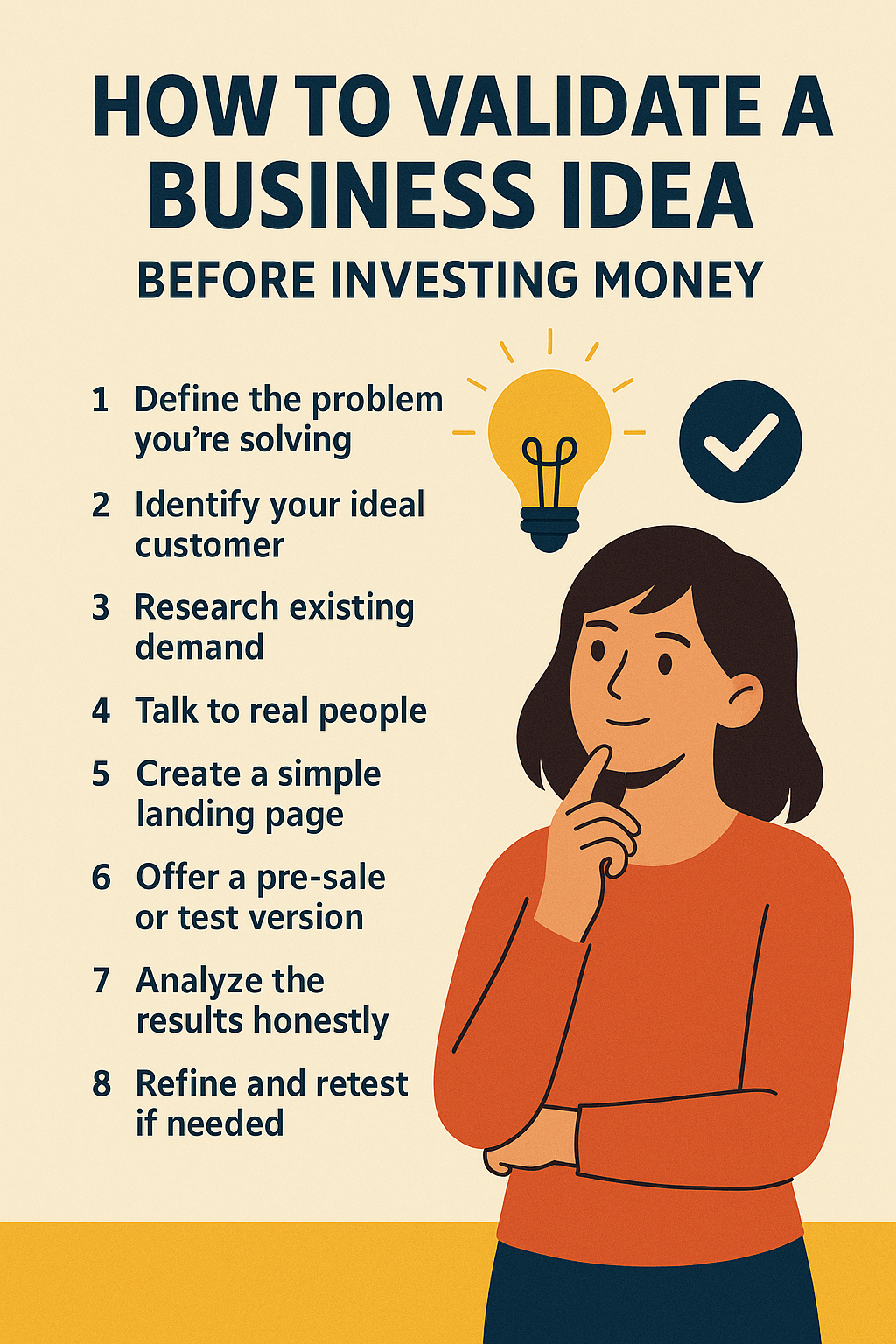You may have a great idea, but how do you know if it will actually work in the real world? Many entrepreneurs rush into launching a business without confirming if there’s genuine demand. This often leads to wasted money, time, and energy. Validating your business idea before investing heavily is one of the smartest steps you can take as a small entrepreneur. In this article, you’ll learn practical, low-cost methods to test and validate your idea before going all in.
Why Idea Validation Matters
Starting a business is always a risk — but you can reduce the risk dramatically with proper validation. The goal is simple: find out if people are willing to pay for what you want to sell.
Benefits of validating your idea:
- Avoids investing in the wrong direction
- Helps refine your offer before launch
- Increases your chances of long-term success
- Boosts your confidence with real data
It’s better to find out early that something won’t work than after spending thousands on logos, websites, and products.
Step 1: Define the Problem You’re Solving
Every good business solves a real problem. Start by clearly stating what problem your idea addresses.
Ask yourself:
- What pain point does this solve?
- Who experiences this problem?
- Is it urgent or occasional?
- Are people actively looking for a solution?
If you can’t answer these questions confidently, your idea may still need refining.
Step 2: Identify Your Ideal Customer
Validation is not just about the product — it’s about the customer. Who exactly do you want to help?
Create a customer persona:
- Age, gender, profession
- Interests and online habits
- Goals and frustrations
Knowing your target audience makes testing much more effective.
Step 3: Research Existing Demand
If people are already searching for your solution or buying similar products, it’s a strong signal of demand.
Ways to research:
- Use Google Trends to see if the topic is growing
- Search on Amazon or Etsy for similar products
- Explore forums like Reddit or Quora to find what people are talking about
- Analyze competitors’ websites and reviews to spot gaps or unmet needs
Don’t worry if others are already doing it — competition is a sign that there’s a market.
Step 4: Talk to Real People
One of the most powerful ways to validate an idea is to talk directly to potential customers. You don’t need hundreds of interviews — 10–15 quality conversations can give you solid insights.
What to ask:
- Have you ever faced [insert problem]?
- How do you currently solve it?
- What do you like or dislike about existing solutions?
- Would you pay for a better option?
Record their answers (with permission), and look for patterns. If no one sees the problem as important, your idea may need a pivot.
Step 5: Create a Simple Landing Page
You don’t need a full website to test your idea. A simple one-page website that explains your offer can help you measure interest.
What to include:
- Headline that describes the problem and solution
- Brief explanation of your product or service
- Call-to-action (CTA), like “Join the waitlist” or “Get early access”
Use a free tool like Carrd, Wix, or Mailchimp landing pages. Then share it on social media or in relevant groups to see how people respond.
Step 6: Offer a Pre-Sale or Test Version
If you want next-level validation, offer a pre-sale or a minimum viable product (MVP) — a simplified version of your offer.
Examples:
- If you’re launching a course, offer a beta version at a lower price
- If you’re creating a product, accept pre-orders
- If it’s a service, offer a discounted test run to a few clients
If people are willing to pay now for something you haven’t built yet, that’s powerful proof of demand.
Step 7: Analyze the Results Honestly
After running your tests, take a step back and look at what you learned. It’s easy to get emotionally attached to your idea, but the goal here is clarity, not confirmation.
Ask:
- Did people show interest?
- Did anyone pay or sign up?
- What feedback did you get?
- What objections came up?
If the results are weak, it’s not the end — it might mean you need to adjust your pricing, messaging, or even the idea itself.
Step 8: Refine and Retest If Needed
Idea validation is a process, not a one-time event. Based on the feedback and results, you may need to:
- Adjust your offer
- Improve your messaging
- Focus on a narrower audience
Then test again.
Each round of testing brings you closer to product-market fit — the sweet spot where your offer meets real customer demand.
Step 9: Avoid the Perfection Trap
You don’t need a finished product to validate. In fact, the less you build before testing, the better. Don’t spend weeks building an app, only to realize no one wants it.
Focus on speed, simplicity, and feedback. Your idea will evolve — that’s normal. Great businesses are built through iteration, not perfection.
Final Words: Test Before You Invest
The worst outcome isn’t failure — it’s wasting time and money on something that was never going to work.
By validating your business idea before launching, you give yourself a massive advantage. You’ll understand your market better, create something people actually want, and launch with confidence.
Start small, move fast, listen closely — and success will follow.
